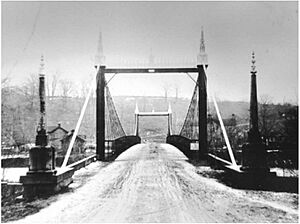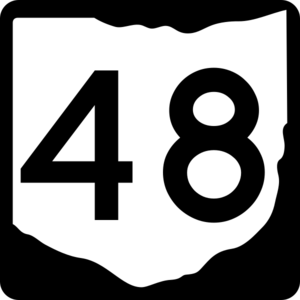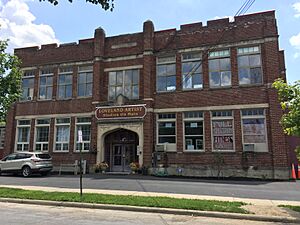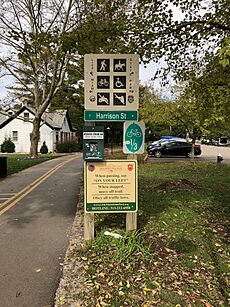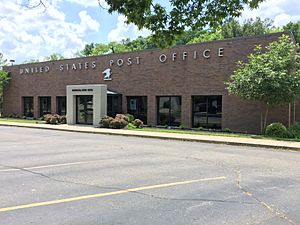Loveland, Ohio facts for kids
Quick facts for kids
Loveland, Ohio
|
|||
|---|---|---|---|
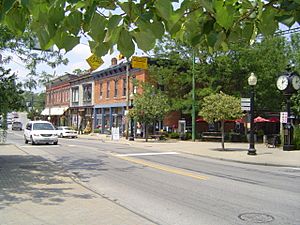
Downtown Loveland at the Loveland Bike Trail crossing. Seen here is Loveland Avenue, originally named Jackson Street.
|
|||
|
|||
| Nickname(s):
Sweetheart of Ohio,
|
|||
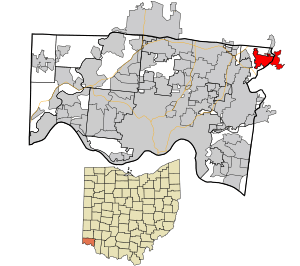
Location in Hamilton County and the state of Ohio.
|
|||
| Country | United States | ||
| State | Ohio | ||
| Counties | Hamilton, Clermont, Warren | ||
| Settled | 1795 | ||
| Incorporated (village) | May 16, 1876 | ||
| Chartered (city) | July 25, 1961 | ||
| Withdrew from townships | 1975 | ||
| Founded by | Col. Thomas Paxton | ||
| Named for | James Loveland | ||
| Government | |||
| • Type | Council–manager | ||
| Area | |||
| • Total | 5.08 sq mi (13.14 km2) | ||
| • Land | 5.00 sq mi (12.94 km2) | ||
| • Water | 0.08 sq mi (0.20 km2) 1.40% | ||
| Elevation | 705 ft (215 m) | ||
| Population
(2020)
|
|||
| • Total | 13,307 | ||
| • Estimate
(2022)
|
13,131 | ||
| • Density | 2,663.00/sq mi (1,028.18/km2) | ||
| Time zone | UTC-5 (EST) | ||
| • Summer (DST) | UTC-4 (EDT) | ||
| ZIP codes |
45140, 45249
|
||
| Area code(s) | 513 | ||
| FIPS code | 39-45108 | ||
| GNIS feature ID | 1085865 | ||
| LOCODE | US XHT | ||
Loveland is a city in southwestern Ohio. It's special because it's located in three different counties: Hamilton, Clermont, and Warren. In 2020, about 13,307 people lived there.
Loveland is part of the larger Cincinnati metropolitan area. It's about 15 miles (24 km) northeast of Cincinnati city limits. The city is close to Interstate 275. It also sits along the Little Miami River. Loveland used to be a busy railroad town. Today, it's a popular spot along the Little Miami Scenic Trail, which is great for biking.
Contents
History of Loveland
Loveland started in an area called the Northwest Territory. This land was once at the edge of two important land purchases.
The city got its name from James Loveland. He ran a general store and post office near the railroad tracks. Loveland became a small village in 1876. Later, in 1961, it officially became a chartered city.
Loveland as a Resort Town
In its early days, Loveland was a popular resort town. Wealthy people built summer homes there. This led to its nickname, "Little Switzerland of the Miami Valley." The Cincinnati YWCA even had a summer cottage here.
Ohio's first paper mill was built near Loveland in 1810. A local road, Kugler Mill, is named after it. The area around Loveland was also famous for its peaches and strawberries.
Railroads and Growth
Railroads were very important for Loveland's growth. The Hillsboro and Cincinnati Railroad connected Loveland to other towns. By 1850, it reached Hillsboro, Ohio. Loveland was a key spot where two major railroads met. This brought many trains, including "40 passenger trains per day."
Another important railway was the Underground Railroad. This was a secret network that helped enslaved people find freedom. Loveland was a stop on its Eastern Route. During the Civil War, Confederate soldiers led by John Hunt Morgan passed through Loveland.
For a long time, people in Loveland needed bridges to cross the Little Miami River. A wooden bridge was built in 1850 but washed away. Later, a large suspension bridge was built in 1871. A second bridge, connecting East and West Loveland, was finished by 1876.
In 1886, scientists found the bones of a mastodon and ancient stone tools in a gravel pit in Loveland.
In 1903, Loveland voted to become a "dry village." This meant they stopped selling alcohol, even before a national ban on alcohol. Loveland was a strong supporter of the Temperance movement.
Flooding has been a challenge for downtown Loveland. The worst flood was in 1913. It destroyed a corn mill and the Loveland Bridge. A new iron bridge was built the next year.
In the 1920s, The Cincinnati Enquirer newspaper gave away free plots of land in Loveland to new subscribers.
Loveland Becomes a City
Loveland's population grew a lot in the 1950s. Because of this, it became a chartered city in 1961. George Anderson was its first mayor. The city also grew by adding smaller nearby communities.
Another big flood in 1959 led to the building of a dike along the Little Miami River in 1962–1963.
The old Little Miami Railroad tracks were turned into a bike trail in the 1980s. This trail became part of the Little Miami Scenic Trail in 1984.
Loveland has tried to expand its borders over the years. In the 1990s, it bought land that was originally the first settlement in the area.
In the late 1990s, Loveland became a Tree City. It also started to improve its Historic Downtown area. They replaced concrete sidewalks with brick ones and added park benches. They also encouraged businesses to improve their buildings.
The Loveland Beautification Committee helps make the town look better. Loveland also promoted itself as a great place for cycling. The Tour de Loveland was an annual bike race. However, the race was canceled in 2005 due to low attendance.
On April 9, 1999, an F4 tornado hit Loveland. It caused damage and sadly, one Loveland resident died.
In 2005, Loveland won the America in Bloom competition for cities its size. It also won an award for youth involvement in the 2006 Communities in Bloom International Challenge.
Geography and Location
Loveland covers about 5 square miles (13 square kilometers). Most of this area is land, with a small amount of water. The city is about 597 feet (182 meters) above sea level.
You can easily reach Loveland by car using Interstate 275. State Route 48 also goes through the city. Other state routes, like State Route 3 / U.S. Route 22 and State Route 126, are nearby.
Loveland is unique because it's located in three different counties: Hamilton, Clermont, and Warren. The historic downtown area is in a valley along the Little Miami River. This river forms the border between Hamilton and Clermont counties. Most of Loveland's homes are on the hills around the valley.
Loveland City Hall is in Clermont County. However, most of the people live in Hamilton County. Loveland is often called a "bedroom community." This means many people live there but travel to Cincinnati for work.
The 513 area code covers all of Loveland. The main ZIP code for the city is 45140.
Population Information
| Historical population | |||
|---|---|---|---|
| Census | Pop. | %± | |
| 1880 | 595 | — | |
| 1890 | 1,153 | 93.8% | |
| 1900 | 1,260 | 9.3% | |
| 1910 | 1,421 | 12.8% | |
| 1920 | 1,557 | 9.6% | |
| 1930 | 1,954 | 25.5% | |
| 1940 | 1,904 | −2.6% | |
| 1950 | 2,149 | 12.9% | |
| 1960 | 5,008 | 133.0% | |
| 1970 | 7,126 | 42.3% | |
| 1980 | 9,106 | 27.8% | |
| 1990 | 9,990 | 9.7% | |
| 2000 | 11,677 | 16.9% | |
| 2010 | 12,081 | 3.5% | |
| 2020 | 13,307 | 10.1% | |
| 2022 (est.) | 13,131 | 8.7% | |
| Sources: | |||
In 1880, Loveland had 595 residents. By 2020, the population grew to 13,307 people.
2020 Census Details
In 2020, there were 13,307 people living in Loveland. Most residents (88.6%) were White. About 2.2% were Black or African American, and 2.3% were Asian. About 3.3% of the population identified as Hispanic or Latino.
About 26% of the city's population was under 18 years old. The average age in Loveland was about 38.6 years.
Economy and Jobs
The Loveland Bike Trail brings many visitors to downtown Loveland. This helps the local economy. There are also some light industries in the Loveland Commerce Park. Companies like Dos Madres Press and Rozzi Fireworks have their main offices in Loveland.
In the past, other companies like Baldwin Piano & Organ Company and Totes Isotoner were based here.
Arts and Culture
Even though Loveland's name comes from a person, the city has embraced a "love" theme. The city's water towers and park signs have a heart logo. This logo includes a sun, clouds, and the Little Miami River, along with the nickname "Sweetheart of Ohio."
The Loveland Post Office is famous for its special Valentine's Day program. Every year since 1972, volunteers help stamp thousands of envelopes with a special Valentine's message. The message says, "There is nothing in this world so sweet as Love." The city also holds a greeting card design contest each year.
The city's mascot is the Loveland frog. This is a legendary humanoid frog from the area.
The Grail, a women's movement organization, has its national headquarters near Loveland. It's called Grailville.
Colemine Records, a record label for soul and funk music, is based in Loveland. It shares a building with its record store, Plaid Room Records.
Parks and Recreation
Biking on the Loveland Bike Trail and canoeing on the Little Miami River are popular activities. Loveland has 16 city parks, including small neighborhood parks and memorials. The Loveland Bike Trail is a popular part of the Little Miami Scenic Trail, which is a state park. You can rent canoes and kayaks from Loveland Canoe & Kayak.
Shield's Crossing, also known as the William Johnston House, is a historic building in Loveland. It's listed on the National Register of Historic Places.
Chateau Laroche, also called the Loveland Castle, is a historical museum and unique building just outside the city.
For indoor fun, there's Castle Skateland, a roller skating rink. The Loveland Stage Company is a theater group that started in 1979. They perform plays in the Crist Theater, an old movie theater.
Education
Loveland has its own public school district, the Loveland City School District. Loveland High School is part of this district. Some parts of Loveland are served by other school districts, like Sycamore Community School District and Kings Local School District.
There are also many private schools near Loveland. These include Cincinnati Hills Christian Academy and Archbishop Moeller High School.
The Public Library of Cincinnati and Hamilton County has a branch library in downtown Loveland. There are also other nearby libraries in Milford and Mason.
Media and News
Loveland is part of the Cincinnati media market. This means you can get Cincinnati TV and radio stations. Cable television is provided by Spectrum.
"Loveland Local News" covers local business, politics, sports, and education. "Loveland Magazine" is an online newspaper. "Eye on Loveland" is a podcast about the city's politics.
The Cincinnati Enquirer used to publish a weekly newspaper called The Loveland Herald. It stopped publishing in 2019.
Infrastructure
Safety and Services
The Loveland Police Division protects the city. The Loveland–Symmes Fire Department provides fire and emergency services. Both use the Northeast Communications Center for dispatching. This center also activates the local tornado sirens.
Loveland gets electricity and natural gas from Duke Energy Ohio. Waste and recycling services are provided by Rumpke. The city also has agreements for water services with Cincinnati and Clermont County.
Notable People
Many interesting people have connections to Loveland:
Arts and Entertainment
- Wilbur G. Adam – a painter and illustrator
- Wendy Barrie-Wilson – a Broadway actress
- Nancy Ford Cones – a photographer whose work appeared in magazines
- Ann Donahue – a television writer
- Vanessa German – a sculptor, painter, writer, and performer
- Emma Montgomery McRae – a professor of English literature
- Lillian Morris – a contestant on Survivor: Pearl Islands
- Ashley Palmer – an actress and singer
- William Schickel – an artist and architect
- Jerry Springer – a former Mayor of Cincinnati and television host
Athletics
- Todd Benzinger – a former Major League Baseball player
- Don Biggs – a retired professional ice hockey player
- Tyler Biggs – an ice hockey player
- Steve Brown – a darts player
- Adam Engel – a professional baseball player for the Chicago White Sox
- Matt Hamill – a mixed martial arts fighter and wrestling champion
- Joe Kelly – a professional football player
- Dan Ketchum – a gold medalist in swimming at the 2004 Summer Olympics
- Tacks Latimer – a professional baseball player
- Henry W. Lever – a college football coach
- Bob Lohr – a professional golfer
- Jack Pfiester – a professional baseball player
- Drew Plitt – a professional football quarterback
- Herb Royer – a college football coach
- Mike Sylvester – a professional basketball player who won a silver medal in the 1980 Summer Olympics
Business
- Cecil Bauer – a former Mayor of Loveland and business owner
- Joshua I. Smith – a founder of Maxima Corporation
Military
- James Hall – an Army captain, writer, and lawyer
Images for kids
See also
 In Spanish: Loveland (Ohio) para niños
In Spanish: Loveland (Ohio) para niños




